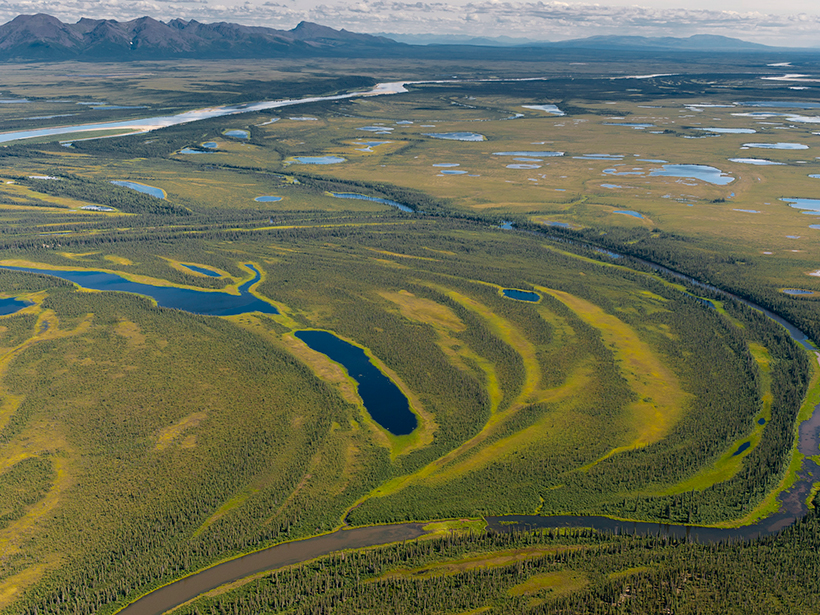Methane (CH4) is a powerful greenhouse gas with the potential to accelerate climate change if emissions substantially increase. Models based on numerous field studies in recent decades estimate large CH4 emissions from wetlands, lakes, and marine shelf environments in the northern permafrost region.
The sum of these emission estimates is about 60 teragrams CH4 per year, or ~25% of global natural CH4 emissions. This is substantially larger than the ~25 teragrams CH4 per year emissions estimated for the region from inversion models based on atmospheric CH4 concentration data. Thus, there is a clear need for the scientific community to resolve this discrepancy and better understand the sensitivity of CH4 emissions to ongoing climate change in the northern permafrost region.
There is a clear need for the scientific community to better understand the sensitivity of methane emissions to ongoing climate change in the northern permafrost region.
A workshop was convened in March to facilitate reconciling estimates based on field measurements and inversion models. It was organized by the Study of Environmental Arctic Change (SEARCH) and funded by the National Science Foundation, NASA, the U.S. Geological Survey, and the U.S. Arctic Research Commission. Forty-two scientists from around the world, with diverse expertise in CH4 dynamics, attended the workshop.
The first day of the workshop included keynote presentations providing atmospheric, inland (wetlands, lakes, and rivers), marine, and remote sensing perspectives on CH4 budgets in the region. The atmospheric presentations identified that forward and inverse models fail to accurately estimate cold season emissions. A crucial question raised was why CH4 emissions in this region have been stable over recent decades, whereas many process-based models indicate that increasing temperatures should have led to a detectable increase in emissions. Key issues identified in inland and marine presentations included the need to standardize the spatial domain, minimize double counting of emissions from lakes and wetlands, reduce bias in field site selections, improve measurements of cold season emissions, and improve scaling of hot spots.
Near-term activities include developing a cross-disciplinary road map for reconciling estimates between models based on field observations and atmospheric data.
During the second day, breakout groups identified key uncertainties and developed plans for addressing them in several near-term and long-term activities. The near-term activities include developing a cross-disciplinary road map for reconciling estimates between models based on field observations and atmospheric data, compiling existing atmospheric observations, synthesizing cold season emissions as well as lake ebullition data, comparing CH4 processes and emissions estimates among the shelves of the Arctic Ocean, and analyzing scaling methodologies. Long-term activities include determining the sensitivities of CH4 emissions to climate variability and change in the region, evaluating the detectability of changes in CH4 dynamics, and developing enhancements to the CH4 observation network to improve trend detection.
The road map for reconciling observations and models will be completed by the end of this year. Workshop teams will make progress on other near-term activities with the intention of completing them by the end of 2018. Substantive progress on long-term activities is expected in the next 3 to 5 years. The SEARCH Permafrost Action Team will track the progress of the workshop’s follow-on activities and will develop research summaries and briefs.
—A. David McGuire (email: [email protected]), Alaska Cooperative Fish and Wildlife Research Unit, U.S. Geological Survey, University of Alaska Fairbanks; Brendan P. Kelly, International Arctic Research Center, University of Alaska Fairbanks; and Lisa Sheffield Guy, The Arctic Research Consortium of the United States, Fairbanks, Alaska
Citation:
McGuire, A. D.,Kelly, B. P., and Sheffield Guy, L. (2017), Resolving a methane mystery in the Arctic, Eos, 98, https://doi.org/10.1029/2017EO076733. Published on 11 July 2017.
Text not subject to copyright.
Except where otherwise noted, images are subject to copyright. Any reuse without express permission from the copyright owner is prohibited.
Text not subject to copyright.
Except where otherwise noted, images are subject to copyright. Any reuse without express permission from the copyright owner is prohibited.

